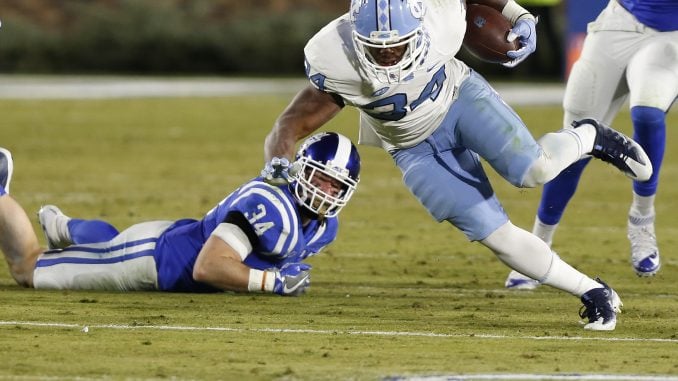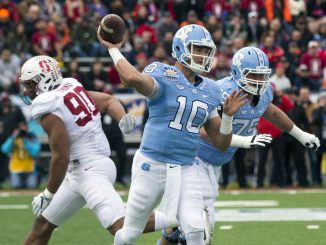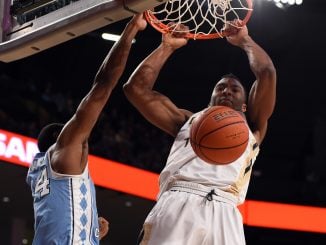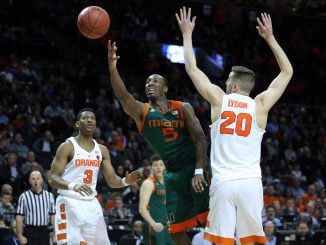
CHAPEL HILL — As loaded questions go, the one posed to Elijah Hood in the aftermath of North Carolina’s loss at Duke on Thursday had about as much baggage as an overbooked airliner on a holiday weekend. Does it hurt your rhythm when you go such long stretches without a carry, the junior running back was asked. It was a pertinent question, considering that the first-team All-ACC performer ran the ball only 13 times against the Blue Devils and for the second straight week, went nearly an entire quarter without a touch. But it was clearly one Hood was uncomfortable answering. “I don’t really know how to respond to that one,” he said with a nervous laugh. The extent of Hood’s contribution to UNC’s offense has been a frequent topic for discussion as both his participation and production have lagged behind expectations this season. He has rushed for 719 yards and eight touchdowns, less than half of his totals of 1,463 yards and 17 scores a year ago. Although his 5.9 yard per carry average isn’t significantly lower, his average of 13.4 rushes per game is. Some of that decreased work load can be attributed to a series of nagging injuries, including a concussion that forced him to miss a game-and-a-half last month. But after gaining more than 100 yards in consecutive wins against Virginia and Georgia Tech, Hood was declared as healthy as he’s been all all season by both himself and coach Larry Fedora. Even though he gained a season-high 168 yards and three touchdowns against Tech, Hood did the damage on only 12 rushing attempts — none of which came in the second quarter. History repeated itself Thursday when after averaging 7.2 yards on his five first quarter carries, the 6-foot, 220-pound workhorse was again missing in action during the second quarter. Seldom-used senior Khris Francis got more carries in the period than Hood, as UNC’s offense, which had produced touchdowns on its first two possessions, came to a screeching halt. In his postgame press conference, Fedora explained that Francis’ two carries — for a combined one yard — came while the Tar Heels were in a two-back set and were the result of the offense “taking what the defense was giving.” When asked about personnel decisions again at his regular Monday press conference, the head coach deferred to his running backs coach Larry Porter. “Larry handles the substitutions with those guys as he sees fit,” Fedora said. “If he thinks something’s happening and he needs to get him out, he gets him out. I don’t think there’s any (health) issues” regarding Hood. Fedora countered that his team ran the ball effectively against Duke and to an extent, it did. Hood and running mate T.J. Logan combined for 104 yards on 19 tries. But with the Tar Heels driving for a go-ahead score in the third quarter of a tied game, neither of those backs had their number called. Instead, UNC opted to give the ball to a wide receiver on a reverse. Anthony Ratliff-Williams, who had touched the ball from scrimmage twice all season, was tackled for a 12-yard loss, forcing the Tar Heels to settle for a field goal. “I don’t do a whole lot of second-guessing on the plays that are called,” Fedora said. “It’s more about why we didn’t execute what was called. “We have capable people whether it’s Elijah that’s carrying it or T.J. is carrying it. We just didn’t execute. There were too many very basic things we didn’t do throughout that game which kept us from being efficient.” Was one of those “very basic things” not giving Hood the ball enough for him to get into a full rhythm? Not necessarily, said quarterback Mitch Trubisky. “It’s not as much him individually as it is our whole offense,” Trubisky said. “When we’re moving the chains, picking up first downs and going down the field, that’s when I think everyone’s at their best. That’s when I think Elijah’s breaking off runs and keeping defenses on their heels. “We just have to get back to basics, everyone’s got to do their job, execute, convert on third downs, that’s when everyone’s at their best. That’s when everyone’s going to touch the ball.” As important as it is to spread the ball around, it also makes sense for some players to touch it more than others based on their production and big play potential. But that’s not a subject Hood is anxious to discuss, especially in public. “I never really think about it when I’m playing,” he said Thursday when asked about his volume of carries. “Whenever I get the ball I just try to make the play.”



